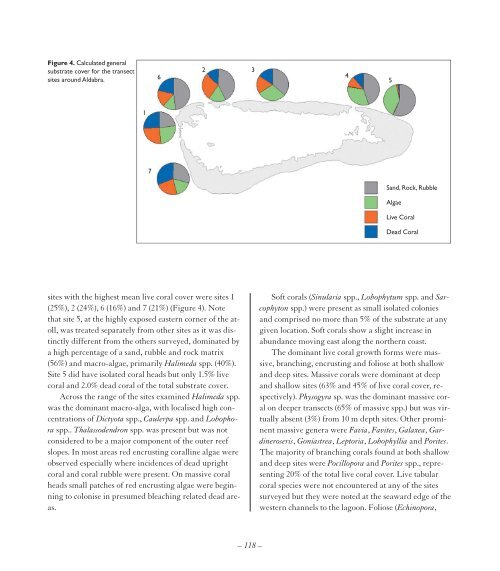Create successful ePaper yourself
Turn your PDF publications into a flip-book with our unique Google optimized e-Paper software.
Figure 4. Calculated general<br />
substrate cover for the transect<br />
sites around Aldabra.<br />
6<br />
2 3<br />
4<br />
5<br />
1<br />
7<br />
Sand, Rock, Rubble<br />
Algae<br />
Live Coral<br />
Dead Coral<br />
sites with the highest mean live coral cover were sites 1<br />
(25%), 2 (24%), 6 (16%) and 7 (21%) (Figure 4). Note<br />
that site 5, at the highly exposed eastern corner of the atoll,<br />
was treated separately from other sites as it was distinctly<br />
different from the others surveyed, dominated by<br />
a high percentage of a sand, rubble and rock matrix<br />
(56%) and macro-algae, primarily Halimeda spp. (40%).<br />
Site 5 did have isolated coral heads but only 1.5% live<br />
coral and 2.0% dead coral of the total substrate cover.<br />
Across the range of the sites examined Halimeda spp.<br />
was the dominant macro-alga, with localised high concentrations<br />
of Dictyota spp., Caulerpa spp. and Lobophora<br />
spp.. Thalassodendron spp. was present but was not<br />
considered to be a major component of the outer reef<br />
slopes. In most areas red encrusting coralline algae were<br />
observed especially where incidences of dead upright<br />
coral and coral rubble were present. On massive coral<br />
heads small patches of red encrusting algae were beginning<br />
to colonise in presumed bleaching related dead areas.<br />
Soft corals (Sinularia spp., Lobophytum spp. and Sarcophyton<br />
spp.) were present as small isolated colonies<br />
and comprised no more than 5% of the substrate at any<br />
given location. Soft corals show a slight increase in<br />
abundance moving east along the northern coast.<br />
The dominant live coral growth forms were massive,<br />
branching, encrusting and foliose at both shallow<br />
and deep sites. Massive corals were dominant at deep<br />
and shallow sites (63% and 45% of live coral cover, respectively).<br />
Physogyra sp. was the dominant massive coral<br />
on deeper transects (65% of massive spp.) but was virtually<br />
absent (3%) from 10 m depth sites. Other prominent<br />
massive genera were Favia, Favites, Galaxea, Gardineroseris,<br />
Goniastrea, Leptoria, Lobophyllia and Porites.<br />
The majority of branching corals found at both shallow<br />
and deep sites were Pocillopora and Porites spp., representing<br />
20% of the total live coral cover. Live tabular<br />
coral species were not encountered at any of the sites<br />
surveyed but they were noted at the seaward edge of the<br />
western channels to the lagoon. Foliose (Echinopora,<br />
– 118 –


















